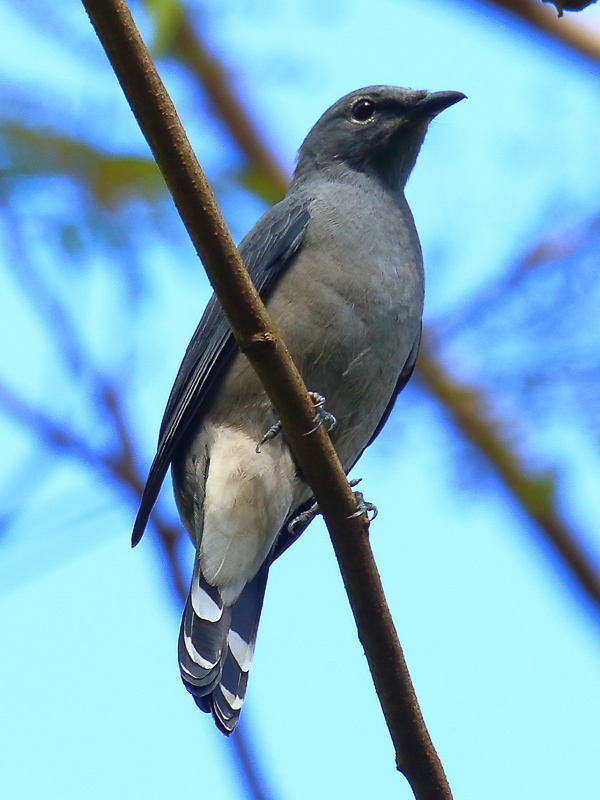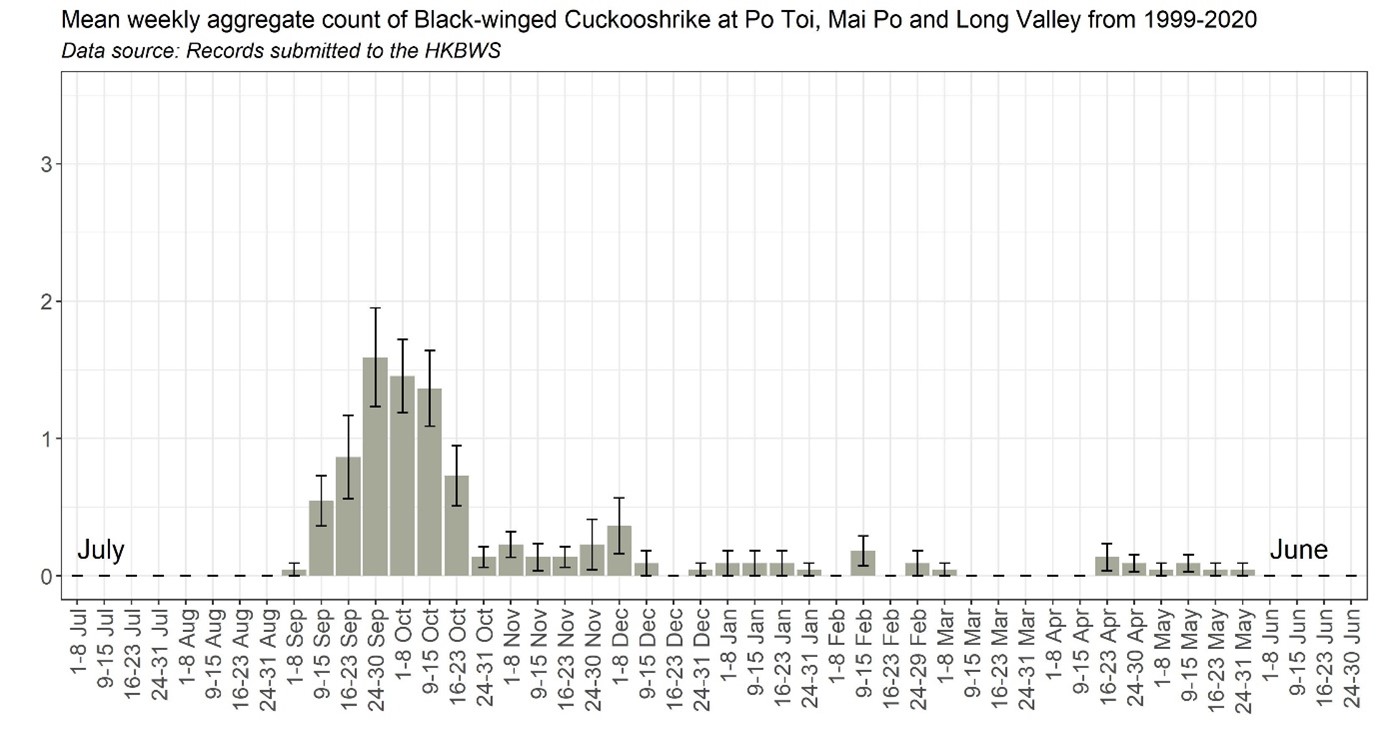Black-winged Cuckooshrike Lalage melaschistos 暗灰鵑鵙
Category I. Scarce winter visitor and passage migrant, with one breeding record in the 1930s; mainly occurs in wooded habitats.
IDENTIFICATION

Nov. 2020, Kenneth Lam. Male.
20-24 cm. A monochrome medium sized passerine that is unobtrusive and difficult to see well; flight is swift but languid with deep beats of long wings. The relatively long tail has distinct white tips on the underside. In flight it shows a paler rump and a white patch on the underwing.
The male is slate-grey, paler on the underparts and has dark grey wings, wing coverts and tail with a green gloss and a diffuse blackish mask.

Dec. 2012, Cherry Wong. Female.
Female is similar to male, but paler, often with weak darker barring on underparts. Immatures are similar but have stronger and more extensive barring below and pale tips to wing and tail feathers.
VOCALISATIONS
Calls infrequently, uttering a variety of nasal rattles and downslurred notes.
The song, which can be heard in late autumn or spring, is generally rhythmic and slightly nasal. In this recording, call notes can also be heard.
It is, however, rather variable, and can also be a short series of loud pure notes.
DISTRIBUTION & HABITAT PREFERENCE
Mostly favours wooded habitats particularly in winter, when birds are frequently recorded on the Tai Mo Shan massif and wooded areas of Sai Kung and Tai Lam. On migration, especially autumn, it is more widespread and occurs in less-wooded habitats such as Mai Po and Po Toi, and occasionally in urban parks such as Victoria, Kowloon, Yuen Long and King’s Parks.
Between the two winter atlas surveys of 2001-05 and 2016-19 its distribution increased from 0.3% to 2.4% of 1km squares. Expansion occurred from the Tai Mo Shan massif in the first survey to include the northwest and northeast New Territories, the Lion Rock, Ma On Shan and Sai Kung East and West country parks and Lantau. This is presumed due to the increase in secondary woodland arising from succession.
OCCURRENCE
Black-winged Cuckooshrike is a common passage migrant in autumn and winter visitor, most numerous from the third week of September to the first week of April. Extreme dates are 28 August 2020 and 26 May 2011. It usually occurs in ones or twos, with the highest count being eight on 22 November 2017 and 10 December 2016.
Figure 1 illustrates the pattern of occurrence at closed-canopy woodland sites in which both wintering and passage birds occur. The winter population is largely present from the final week of October to the first week of April, with a slight but gradual decline as the winter progresses.
Figure 2 illustrates in more detail presence at sites where it is largely a migrant (Mai Po, Long Valley and Po Toi). It occurs mainly from the second week of September to the third week of October. Small numbers in the midwinter period indicate that birds rarely occur in winter. Return passage in spring is much less marked and lasts from the third week of April to the last week of May.
Black-winged Cuckooshrike was first recorded by Kershaw (1904), who stated it was an uncommon resident. Vaughan and Jones (1913) regarded it as winter visitor in HK, although they also found it breeding on the West River, Guangdong. The sole confirmed breeding record in HK occurred in July 1934 (Pereira 1934). Additionally, summer records have since occurred at Mount Austin on 18 June 1971, Fanling Golf Course on 3 June 1978 and at Pok Fu Lam on 25 June 1991.
BREEDING
A nest with three fully-fledged young was recorded in early July 1934 (Pereira 1934).
BEHAVIOUR, FORAGING & DIET
Mostly occurs in ones or twos, rarely over four individuals. Unobtrusive and usually silent, it keeps to denser parts of the canopy and readily joins mixed foraging flocks, often with minivets. Few data regarding diet, though one was photographed feeding on a mantis nymph.
RANGE & SYSTEMATICS
Of the four subspecies, L. m. intermedia occurs in HK, breeding in central, east and southeast China (Gansu to Hebei south to Guangxi and Guangdong). Other taxa breed in the Himalayas east through north Indochina to Hainan; in the non-breeding season it occurs in north India, Indochina, south China and Taiwan (Taylor 2020).
CONSERVATION STATUS
IUCN: Least Concern. Population trend decreasing.
Figure 1.

Figure 2.

Kershaw, J. C. (1904). List of birds of the Quangtung Coast. China. Ibis 1904: 42-43.
Liu, Y. and Y. H. Chen (eds) (2020). The CNG Field Guide to the Birds of China (in Chinese). Hunan Science and Technology Publication House, Changsha.
Pereira, R. A. (1934). Notes and comments. Ornithology. Hong Kong Naturalist 5: 227-228.
Taylor, B. (2020). Black-winged Cuckooshrike (Lalage melaschistos), version 1.0. In Birds of the World (J. del Hoyo, A. Elliott, J. Sargatal, D. A. Christie, and E. de Juana, Editors). Cornell Lab of Ornithology, Ithaca, NY, USA. https://doi.org/10.2173/bow.bkwcus1.01
Vaughan, R. E. and K. H. Jones. (1913). The birds of Hong Kong, Macao and the West River or Si Kiang in South-East China, with special reference to their nidification and seasonal movements. Ibis 1913: 17-76, 163-201, 351-384.

